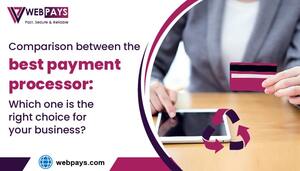Choosing the Best Payment Processor for Your Small Business
الجسم
Selecting the best payment processor for your small business is a crucial decision that can impact your financial bottom line. With the array of options and pricing models available, it can be challenging to determine which one suits your business best. This article breaks down the essential considerations and options to help you make an informed choice.
Understanding Payment Processor Pricing Models
The best payment processing companies offer various pricing models, and understanding these models is key to selecting the right one. The two most common pricing models are interchange-plus pricing and tiered pricing.
- Interchange-Plus Pricing: This model involves paying the actual interchange fee set by card networks like Visa and Mastercard, along with a small markup from the processor. It is known for its transparency, as you can clearly see what the processor charges above the actual cost.
- Tiered Pricing: In tiered pricing, transactions are grouped into different "tiers" based on factors like card type, and a fixed rate is charged for each tier. While tiered pricing offers predictability with set rates, it can be confusing, and fees may be higher. Traditional processors like Chase Paymentech and First Data often use this model.
The choice between these models should be based on your business's specific needs and transaction volumes. Negotiating with processors for the best deal is encouraged, as even a small reduction in fees can lead to significant annual savings.
Flat-Rate Pricing: What to Look for in Payment Processors
Flat-rate pricing can be an attractive option provided by the best payment processing companies for small businesses. With this model, you pay a fixed fee for each transaction, regardless of the payment method. To make the most of flat-rate pricing, consider the following factors:
- Seek Transparent Pricing: The best flat-rate processors are upfront about their fees, listing prices clearly on their website. Transparency ensures you know exactly what you're paying for different types of transactions.
- Consider Your Average Transaction Size: Flat rates work best when your average sale amount is over $10-$15. For transactions below this range, a percentage-based plan may be more cost-effective.
- Examine Additional Fees: Some flat-rate processors charge extra fees for services like address verification, chargebacks, or reporting. It's essential to understand all potential fees to avoid any surprises.
- Look for Competitive Rates: While flat-rate pricing is convenient, you'll still want a good deal. Compare rates across different processors to find a plan that fits your budget. A competitive rate typically ranges from $0.10 to $0.30 per transaction.
Interchange-Plus Pricing: When It's the Right Fit for Your Business
Interchange-plus pricing is ideal for businesses with consistent, steady transactions, typically mid-sized companies. With this model, you pay a small markup fee (usually less than 1%) over the actual interchange rate for each transaction. Interchange-plus pricing offers several benefits, including:
- Predictable Pricing: Since interchange rates are set by card brands like Visa and Mastercard, you know precisely what the underlying costs are for each transaction. The markup fee remains constant, simplifying budgeting and forecasting.
- Potential Cost Savings: If your business has a loyal customer base and low chargeback rates, interchange-plus pricing can often save you money compared to tiered pricing. The markup fee is usually lower, and you aren't subsidizing riskier merchants.
- Transparent Statements: Interchange-plus statements provide transparency, displaying interchange categories, rates, and markup for each transaction. There are no bundled tiers or misleading labels, ensuring you see precisely what you're paying for each card type and transaction.
- Negotiable Terms: With interchange-plus pricing, you can often negotiate the markup percentage, monthly fees, and contract terms with your processor. Look for a processor offering competitive, transparent interchange-plus plans and reasonable early termination fees if you ever decide to switch providers.
However, interchange-plus pricing may not be the best option for businesses just starting, those with erratic sales, or those anticipating a high percentage of chargebacks and non-qualified surcharges.
Tiered Pricing: Pros and Cons for Small Businesses
Tiered pricing models offer different rates based on transaction volume or sales, and they can be advantageous for small businesses. Some of the pros and cons of tiered pricing include:
Pros:
- Cost Savings: As your business grows and processes more payments, your fees generally decrease, reducing expenses and increasing profits over time.
- Transparency: Tiered pricing provides upfront transparency, making it easier to predict costs at different volume levels.
Cons:
- Potential for High Fees: If your business processes only a small number of payments, the fees may seem high, and some providers may require a monthly minimum fee regardless of your volume.
- Complex Comparison: Comparing tiered pricing across providers can be challenging, as each company structures its tiers and rates differently. You need to evaluate them carefully based on your expected payment volume.
Conclusion
In conclusion, selecting the best payment processor for your small business involves assessing various factors, including your transaction volume, average sale amount, and the specific fees and features that best suit your business. By thoroughly evaluating your options and negotiating for the best deal, you can find the best payment processor that aligns with your business's needs and helps you save on processing fees.












تعليقات